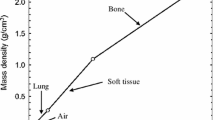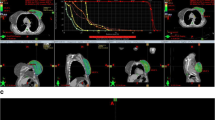Abstract
This study verified the dose calculation accuracy of the analytical anisotropic algorithm (AAA), Acuros XB version 10 (AXB10), and version 11 (AXB11) installed in an Eclipse treatment planning system, by comparing with Monte Carlo (MC) simulations. First, the algorithms were compared in terms of dose distributions using four types of virtual heterogeneous multi-layer phantom for 6 and 15 MV photons. Next, the clinical head and neck intensity-modulated radiation therapy (IMRT) dose distributions for 6 MV photons were evaluated using dose volume histograms (DVHs) and three-dimensional gamma analysis. In percentage depth doses (PDDs) for virtual heterogeneous phantoms, AAA overestimated absorbed doses in the air cavity, bone, and aluminum in comparison with MC, AXB10, and AXB11. The PDDs of AXB10 almost agreed with those of MC and AXB11, except for the air cavity. The dose in the air cavity was higher for AXB10 than for AXB11, because their electron cutoff energies are set at 500 and 200 keV, respectively. For head and neck IMRT dose distributions, the D95 in the clinical target volume (CTV) for AAA was almost the same as that for AXB10 and was approximately 7 % larger than that for MC. Comparing each approach with MC using a criterion of 3 %/3 mm, the pass rates for AXB10, AXB11, and AAA were 92.4, 94.7, and 90.4 % in the CTV, respectively. In conclusion, AAA produces dose errors in heterogeneous regions, while AXB11 provides calculation accuracy comparable to MC. AXB10 overestimates the dose in regions that include an air cavity.









Similar content being viewed by others
References
Mell LK, Roeske JC, Mundt AJ. A survey of intensity-modulated radiation therapy use in the United States. Cancer. 2003;98:204–11.
De Neve W, Duthoy W. Intensity-modulated radiation therapy for head and neck cancer. Expert Rev Anticancer Ther. 2004;4:425–34.
Grégoire V, De Neve W, Eisbruch A, et al. Intensity-modulated radiation therapy for head and neck carcinoma. Oncologist. 2007;12:555–64.
Sakthi N, Keall P, Mihaylov I, et al. Monte Carlo-based dosimetry of head-and-neck patients treated with SIB-IMRT. Int J Radiat Oncol Biol Phys. 2006;64:968–77.
Han T, Mikell JK, Salehpour M, et al. Dosimetric comparison of Acuros XB deterministic radiation transport method with Monte Carlo and model-based convolution methods in heterogeneous media. Med Phys. 2011;38:2651–64.
Bush K, Gagne IM, Zavgorodni S, et al. Dosimetric validation of Acuros XB with Monte Carlo methods for photon dose calculations. Med Phys. 2011;38:2208–21.
Han T, Followill D, Mikell J, et al. Dosimetric impact of Acuros XB deterministic radiation transport algorithm for heterogeneous dose calculation in lung cancer. Med Phys. 2013;40:51710–21.
Mißlbeck M, Kneschaurek P. Comparison between Acuros XB and Brainlab Monte Carlo algorithms for photon dose calculation. Strahlenther Onkol. 2012;188:599–605.
Kan MW, Leung LH, Yu PK. Dosimetric impact of using the Acuros XB algorithm for intensity modulated radiation therapy and RapidArc planning in nasopharyngeal carcinomas. Int J Radiat Oncol Biol Phys. 2013;85:73–80.
Kroon PS, Hol S, Essers M. Dosimetric accuracy and clinical quality of Acuros XB and AAA dose calculation algorithm for stereotactic and conventional lung volumetric modulated arc therapy plans. Radiat Oncol. 2013;8:149.
Kan MW, Leung LH, Yu PK. Verification and dosimetric impact of Acuros XB algorithm on intensity modulated stereotactic radiotherapy for locally persistent nasopharyngeal carcinoma. Med Phys. 2012;39:4704–14.
Fogliata A, Nicolini G, Clivio A, et al. Dosimetric evaluation of Acuros XB Advanced Dose Calculation algorithm in heterogeneous media. Radiat Oncol. 2011;6:82.
Tsuruta Y, Nakata M, Nakamura M, et al. Dosimetric comparison of Acuros XB, AAA, and XVMC in stereotactic body radiotherapy for lung cancer. Med Phys. 2014;41:081715.
Koo T, Chung JB, Eom KY, et al. Dosimetric effects of the acuros XB and anisotropic analytical algorithm on volumetric modulated arc therapy planning for prostate cancer using an endorectal balloon. Radiat Oncol. 2015;10:48.
Han T, Mourtada F, Kisling K, et al. Experimental validation of deterministic Acuros XB algorithm for IMRT and VMAT dose calculations with the Radiological Physics Center’s head and neck phantom. Med Phys. 2012;39:2193–202.
Fogliata A, Nicolini G, Vanetti E, et al. Dosimetric validation of the anisotropic analytical algorithm for photon dose calculation: fundamental characterization in water. Phys Med Biol. 2006;51(6):1421–38.
Breitman K, Rathee S, Newcomb C, et al. Experimental validation of the Eclipse AAA algorithm. J Appl Clin Med Phys. 2007;8:76–92.
Kawrakow I. Accurate condensed history Monte Carlo simulation of electron transport. I. EGSnrc, the new EGS4 version. Med Phys. 2000;27:485–98.
Kawrakow I, Rogers DW, Tessier F et al. The EGSnrc code system: Monte Carlo simulation of electron and photon transport. National Research Council of Canada Report PIRS-701 2013.
Rogers DW, Faddegon BA, Ding GX, et al. BEAM: a Monte Carlo code to simulate radiotherapy treatment units. Med Phys. 1995;22:503–24.
Rogers DW, Walters BR and Kawrakow I. BEAMnrc users manual. National Research Council of Canada Report PIRS-509(A) Rev L, 2013.
Araki F. Monte Carlo-based correction factors for ion chamber dosimetry in heterogeneous phantoms for megavoltage photon beams. Phys Med Biol. 2012;57:7615–27.
Araki F, Ohno T The response of a radiophotoluminescent glass dosimeter in megavoltage photon and electron beams. Med Phys. 2014;41: 22102-1-22102-8.
Tomiyama Y, Araki F, Ohno T, et al. Three-dimensional gamma analysis of dose distributions in each structure for IMRT dose verification. Radiol Phys Technol. 2014;7:303–9.
Walters BR, Kawrakow I, Rogers DW. DOSXYZnrc users manual. National Research Council of Canada, Report PIRS-794 Rev B, 2013.
Sterpin E, Tomsej M, De Smedt B, et al. Monte Carlo evaluation of the AAA treatment planning algorithm in a heterogeneous multilayer phantom and IMRT clinical treatments for an Elekta SL25 linear accelerator. Med Phys. 2007;34:1665–77.
Low DA, Harms WB, Mutic S, et al. A technique for the quantitative evaluation of dose distributions. Med Phys. 1998;25:656–61.
Verbakel WF, Cuijpers JP, Hoffmans D, et al. Volumetric intensity-modulated arc therapy vs conventional IMRT in head-and-neck cancer: a comparative planning and dosimetric study. Int J Radiat Oncol Biol Phys. 2009;74:252–9.
Blanpain B, Mercier D. The delta envelope: a technique for dose distribution comparison. Med Phys. 2009;36:797–808.
Seltzer SM, Hubbell JH. Tables and graphs of photon mass attenuation coefficients and mass energy-absorption coefficients for photon energies 1 keV to 20 MeV for elements Z = 1 to 92, in The X-ray Attenuation and Absorption for Materials of Dosimetric Interest Database. USA: NIST; 1996.
ESTAR: stopping powers and ranges for electrons, national institute of standards and technology: http://physics.nist.gov/PhysRefData/Star/Text/ESTAR.html.
Rogers DW, Kawrakow I, Seuntjens JP et al. NRC user codes for EGSnrc. National Research Council of Canada Report PIRS-702 Rev C; 2013.
Kan MW, Leung LH, So RW, et al. Experimental verification of the Acuros XB and AAA dose calculation adjacent to heterogeneous media for IMRT and RapidArc of nasopharyngeal carcinoma. Med Phys. 2013;40:031714.
Acknowledgments
The authors would like to thank the staff of Kumamoto University Hospital for their help and discussion during this work, and Varian Medical Systems in Japan for providing AXB11.
Author information
Authors and Affiliations
Corresponding author
Ethics declarations
Conflict of interest
The authors declare that they have no conflict of interest.
About this article
Cite this article
Onizuka, R., Araki, F., Ohno, T. et al. Accuracy of dose calculation algorithms for virtual heterogeneous phantoms and intensity-modulated radiation therapy in the head and neck. Radiol Phys Technol 9, 77–87 (2016). https://doi.org/10.1007/s12194-015-0336-z
Received:
Revised:
Accepted:
Published:
Issue Date:
DOI: https://doi.org/10.1007/s12194-015-0336-z




